If you’ve heard about yoga and Pilates but don’t know which one to choose, you’re not alone. Although both of these low-impact workouts seem similar, they offer different benefits. Yoga helps with flexibility and relaxation, while Pilates focuses on core strength and posture. But the real question is, if you only have 30 minutes to exercise, should you do yoga or Pilates?
This guide will explain what makes them different and which is better for your goals. You’ll also learn how to combine both with guidance from certified trainers so you get the most out of your workouts.
Yoga vs Pilates: An Overview
Before anything else, let’s understand the differences between these two workout routines:
What Is Yoga And Its Types?
Yoga is an ancient practice that originated in India 5,000+ years ago. It combines physical poses and breathing techniques to improve body awareness and mindfulness. The word yoga means “to unite,” referring to the harmony between body and mind. Yoga can support emotional health, flexibility, and stress relief when practiced regularly.

Yoga is an ancient practice
A few types of Yoga include:
| Type of Yoga | Pace & Intensity | Primary Focus | Best For |
|---|---|---|---|
| Hatha Yoga | Slow and gentle | Basic poses and breathing | Beginners and flexibility training |
| Vinyasa Yoga | Fast-paced and flowing | Continuous movement and stamina | Cardio, strength, and coordination |
| Ashtanga Yoga | Structured and Intense | Fixed sequence and discipline | Experienced practitioners |
| Yin Yoga | Very slow and deep | Long-held passive stretches | Flexibility and joint health |
| Restorative Yoga | Extremely gentle | Full body relaxation with props | Stress relief and recovery |
What Is Pilates And Its Types?
Pilates is a form of low-impact exercise developed in the 1920s by Joseph Pilates in Germany. Originally used to help injured soldiers regain mobility, it later became popular among dancers and athletes. The method focuses on core strength, controlled breathing, body alignment, and muscular balance. Similarly, it’s widely used for posture correction, injury recovery, and overall muscle control.
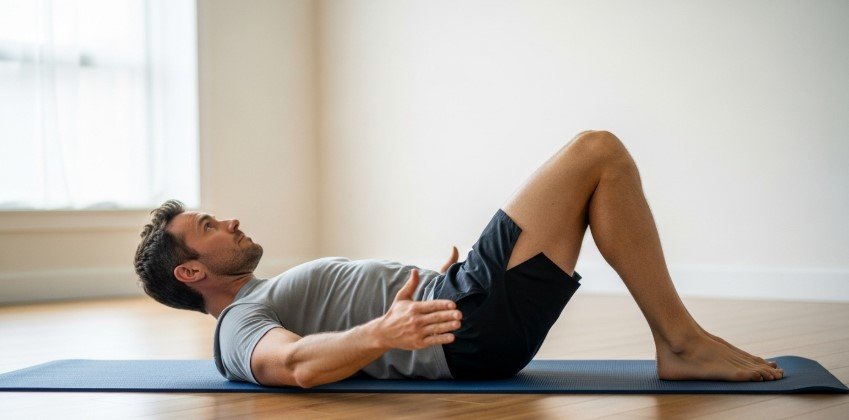
Pilates is a low-impact exercise
Although most routines are mat-based, like in yoga, a few use specialized equipment like the Reformer. It has the following types:
| Types of Pilates | Equipment Used | Primary Focus | Best For |
|---|---|---|---|
| Mat Pilates | Mat only | Core strength using bodyweight | Beginners and home workouts |
| Reformer Pilates | Reformer machine (springs) | Resistance, control, and full-body strength | Muscle toning and advanced users |
| Clinical Pilates | Custom equipment (if needed) | Injury recovery with guided movemen | Rehab or medical conditions |
| Contemporary Pilates | Mixed (mat + equipment) | Combines modern science with tradition | Custom goals and flexibility |
Difference Between Yoga And Pilates
Moving forward, go through the following sections to better understand the differences between these two workout frameworks:
Core Focus
Yoga emphasizes flexibility, balance, and mind-body connection through held poses and pranayama. It engages both isotonic and isometric muscle actions and has been shown to significantly improve balance in older adults, according to systematic review data on mobility outcomes.
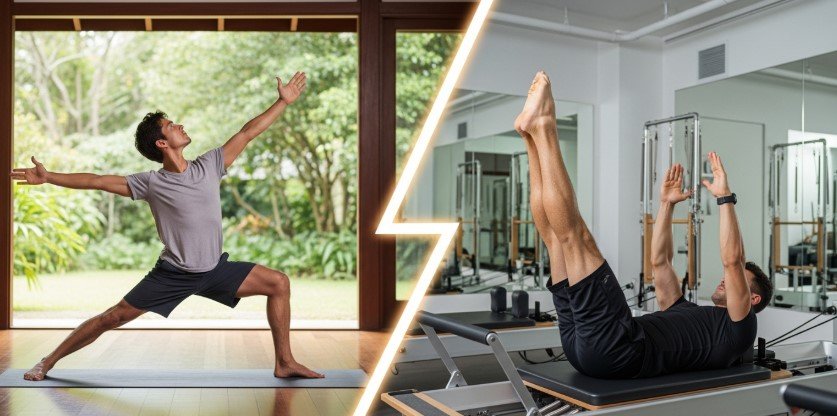
Yoga focuses on mindfulness, while Pilates focus on control
On the other hand, Pilates focuses more on core control and stabilization through repetitive and precise movements. Its foundational principles, i.e., centering, concentration, control, breathing, alignment, flow, and precision, help promote posture and proprioception.
Fitness Goals
According to a PubMed study, Pilates may slightly outperform yoga in improving walking speed and life quality. However, the choice also depends on your specific goals, and the following table will help you with that:
| Fitness Goal | Better Option | Why This Is Better |
|---|---|---|
| Flexibility Improvement | Yoga | Involves deeper stretches and longer holds that increase joint range and mobility. |
| Core Strength | Pilates | Focuses heavily on core isolation and controlled movements for abdominal strength. |
| Posture Correction | Pilates | Strengthens postural muscles and improves spinal alignment more directly. |
| Mental Well-being | Yoga | Emphasizes breathwork and meditation, which reduces stress and improves calm. |
| Recovery & Rehab | Pilates | Designed with therapeutic movements ideal for injury recovery and stability. |
| Weight Management | Yoga | Power and Vinyasa styles increase heart rate and aid in fat loss more effectively. |
| Athletic Performance | Pilates | Builds balanced strength and core stability to support performance and prevent injury. |
Equipment And Style
Yoga typically uses only a mat and optional props like blocks or bolsters for flexibility and support. The following table lists the fitness equipment needed for yoga:
| Equipment | Purpose |
|---|---|
| Yoga Mat | Provides grip and cushioning for poses and transitions |
| Yoga Blocks | Helps maintain balance and alignment during standing or seated poses |
| Yoga Strap | Aids in deepening stretches and improving flexibility |
| Bolster | Offers support for restorative and gentle poses |
| Meditation Cushion | Provides comfort during seated meditation and breathing practices |
Similarly, Pilates may also involve mats or specialized reformer machines with springs and pulleys. Pilates teachers often utilize accessories such as resistance circles or foam rollers to enhance control and alignment. A brief table explaining and listing the equipment needed for Pilates is:
| Equipment | Purpose |
|---|---|
| Reformer Machine | Uses springs and pulleys for full-body resistance training |
| Pilates Ring (Circle) | Enhances core strength and tones arms and thighs |
| Foam Roller | Improves posture and supports muscle recovery |
| Resistance Bands | Adds scalable resistance for controlled strength movements |
| Pilates Chair | Builds strength, balance, and control using spring-loaded resistance |
| Stability Ball | Improves balance and targets deep core muscles |
This equipment is designed according to the exercise’s requirements. For example, yoga sessions tend to flow or hold poses. On the other hand, Pilates movements follow faster and precise reps without rest periods between individual muscle activations.
Training Integration
You don’t have to choose between the two, and can proceed with integrating Pilates and yoga in your daily routine. For this, certified personal trainers blend Pilates core circuits with yoga cooling sequences. This approach supports recovery and consistency over time.
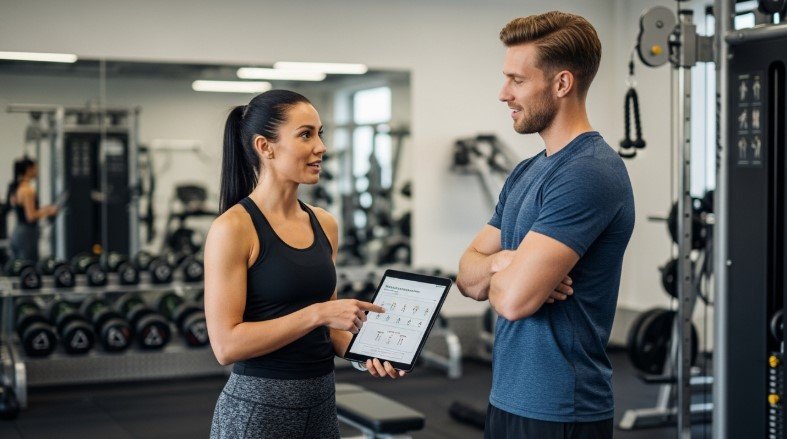
Most trainers introduce Pilates intervals to focus on the core, and yoga flow sessions restore mobility and breath control. Once you perform these exercises under professional supervision, your performance and fitness will enhance significantly.
When To Choose Which
Even though it is recommended to combine both, there might be situations where you want to choose between the two. You should choose yoga when:
- You want to reduce stress and improve mental clarity.
- Your focus is on flexibility and joint mobility.
- You’re seeking spiritual or meditative elements in your routine.
- You enjoy a slower-paced and breath-focused practice.
However, Pilates might suit you better if:
- You want to build core strength and improve posture.
- You’re recovering from an injury.
- You aim to tone muscles without adding bulk.
- You prefer structured workouts.
- You’re focused on alignment and controlled movement.
Conclusion
To conclude, yoga focuses on flexibility and mental clarity, while Pilates targets core strength and controlled movements. You can choose between them depending on your goals, such as mobility and breath, or posture and rehabilitation.
Many people find value in combining both practices or alternating sessions for a balanced fitness experience. Similarly, certified guidance from qualified trainers at FIT4IT ensures proper progression in either practice.
Was this helpful?
Good job! Please give your positive feedback
How could we improve this post? Please Help us.
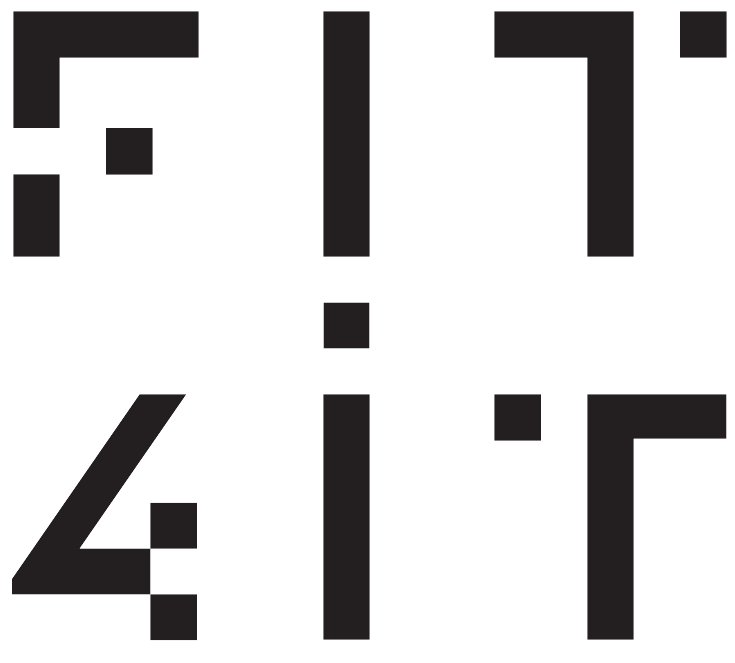


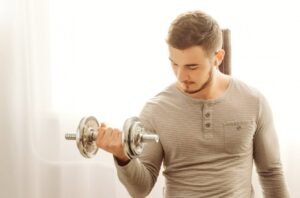


No Comments